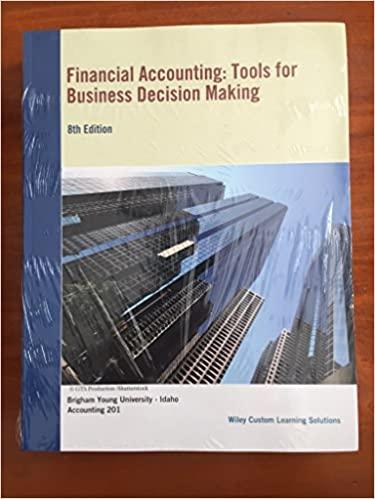Question
2. For each item listed, indicate which section of the cash flow statement it would be classified under (O = Operating, I = Investing, F
2. For each item listed, indicate which section of the cash flow statement it would be classified under (O = Operating, I = Investing, F = Financing, NC = Investing or Financing Activity not affecting cash) and indicate whether the item would be shown as an increase (+) or decrease (-). If the item would not be reported in the statement (or accompanying schedule), indicate this with an X. (Hint: you will find some of these discussed in Chapter 13, but not all. For those not directly referenced in Chapter 13, you may need to refer to previous chapters, especially as it relates to showing impact on the accounting equation. Also, several of these may have an effect on more than one section of the cash flow statement. Assume the Indirect Approach for the Operating Section is used. (15 pts)
a. Increase in deferred income taxes payable.
b. Amortization of premium on bonds payable, semiannual payment date.
c. Purchase of an investment in 60-day Treasury Securities.
d. Adjusting entry for inventory shrinkage.
e. Depletion expense on natural resource.
f. Adjusting entry for bad debt expense (assume allowance method; aging approach).
g. Monthly payment of interest and principal on installment note payable.
h. Loss from Impairment of Goodwill.
i. Increase in Unfunded Pension Liability.
j. Loss on bond redemption.
Financial Statement Analysis Section
For this section you will be using Chapter 14 as a guide and you will also rely on previous chapters in Acct& 201 and 202.
Show all percentages and decimal computations to the nearest 10th (example: percentage = 18.3%, decimal = .2)
Be sure to provide adequate written explanation where requested. Being too brief is a common place to lose points.
Be sure to show your work for all calculations and CIRCLE ALL FINAL ANSWERS, especially the ratios!
You can access Starbucks annual report for 2019 by following the directions in #3 of this section of the test.
You will want to print the financial statements but dont print anything else because the report is very long, especially the notes.
1. Prepare common size Income Statements and Balance Sheets for Starbucks for 2019 and 2018 using vertical analysis as shown in Chapter 14. For the Income Statement, use Total Net Revenues as the base. You should include all items shown on Starbucks Statement of Income and Balance Sheet (dont condense Current Assets into one number; show each Current Asset separately). Comment on why vertical analysis and common size statements are useful for analyzing the performance of a company and give two or three specific examples from your Starbucks computations. (20 pts)
2. Using the Financial Statements from Starbucks 2019 Annual Report compute the following ratios for 2018 and 2019. You will find the ratio formulas in Chapter 14. You must show your work for these computations! Also, for any computations requiring Net Income, use Net Earnings Attributable to Starbucks. (40 pts)
a. Working Capital
b. Current Ratio
c. Quick Ratio
d. Accounts Receivable Turnover
e. Number of Days Sales in Receivables
f. Inventory Turnover
g. Number of Days Sales in Inventory
h. Ratio of Fixed Assets to Long-Term Liabilities
i. Ratio of Liabilities to Stockholders Equity
j. Ratio of Liabilities to Total Assets
k. Times Interest Earned
l. Profit Margin
m. Asset Turnover
n. Return on Total Assets
o. Return on Stockholders Equity
p. Earnings per Share (EPS) on Common Stock
q. Free Cash Flow (see Chapter 13)
r. Ratio of Free Cash Flow to Sales (see Chapter 13)
s. Price-Earnings (P/E) Ratio (For Market Price, find Starbucks stock price as of Sept. 29, 2019; For EPS, use Basic EPS)
t. Dividends per Share
u. Dividend Yield
v. Would you invest in Starbucks? Clearly and thoroughly explain your reasoning. To support your answer, you must speak to each of the following: Liquidity; Solvency; and Profitability. You must use at least two ratios from each of the categories to support your logic. You can also use any additional factors, information, or research to justify your response. When identifying the ratios, be sure to do the following:
i. Name each ratio.
ii. Indicate the importance of the ratio (what it is intending to measure).
iii. Explain why you chose the ratio to justify your decision.
Please Note: your answer to v could count up to of the total points allocated to question 2 (especially if you choose to leave this question blank); be sure to give adequate thought and effort to this question and be sure to use your own words. Even though you may be working with other classmates, any written parts of this exam must not be the same as someone elses.
Step by Step Solution
There are 3 Steps involved in it
Step: 1

Get Instant Access to Expert-Tailored Solutions
See step-by-step solutions with expert insights and AI powered tools for academic success
Step: 2

Step: 3

Ace Your Homework with AI
Get the answers you need in no time with our AI-driven, step-by-step assistance
Get Started


